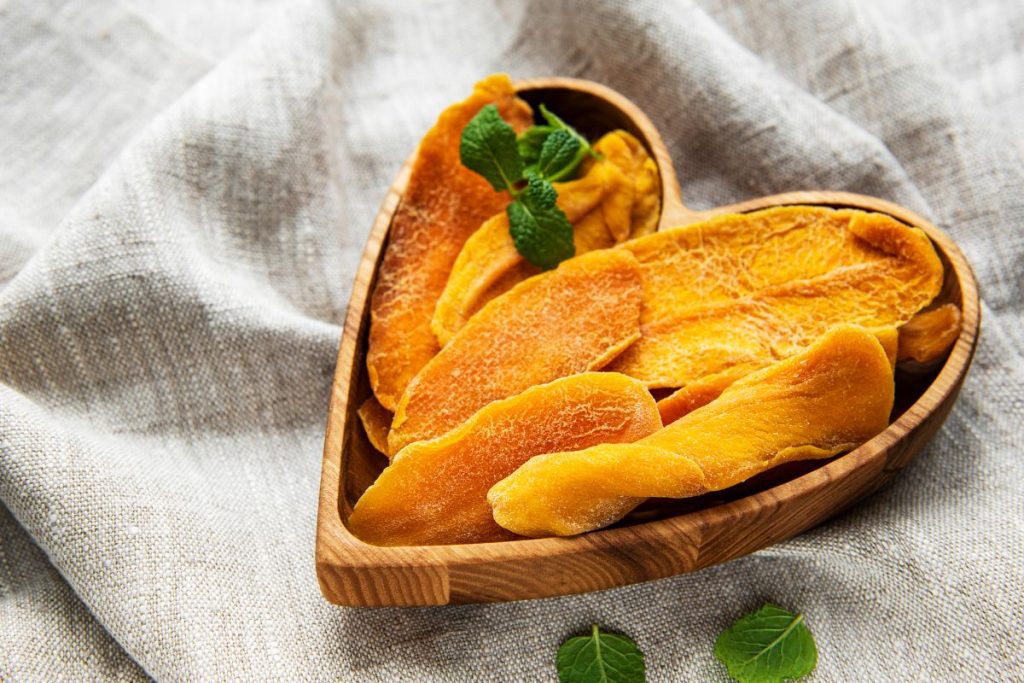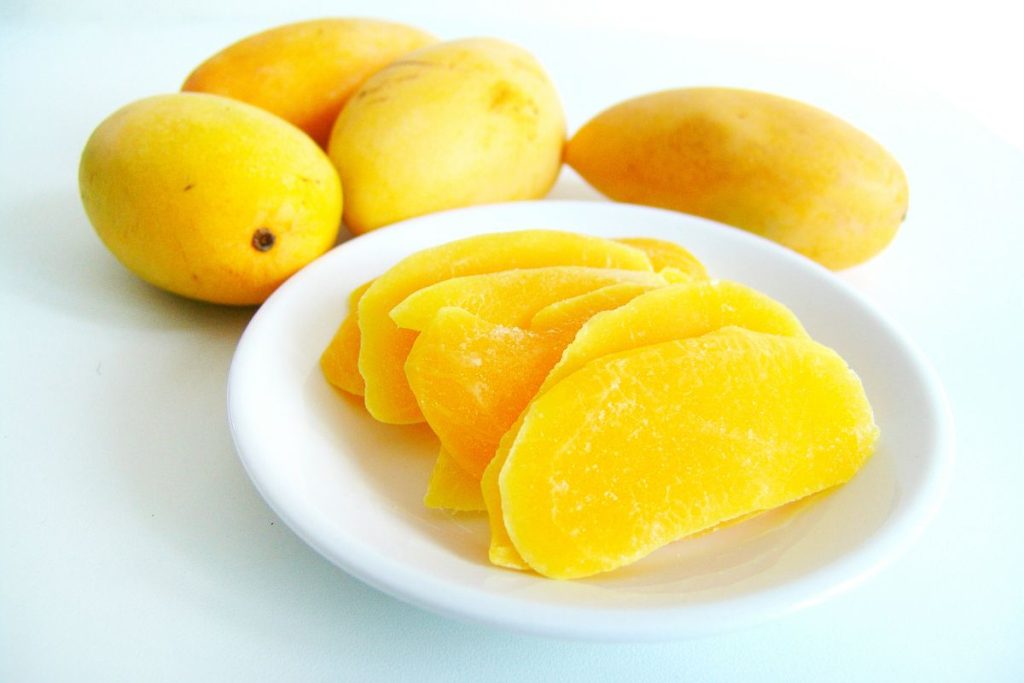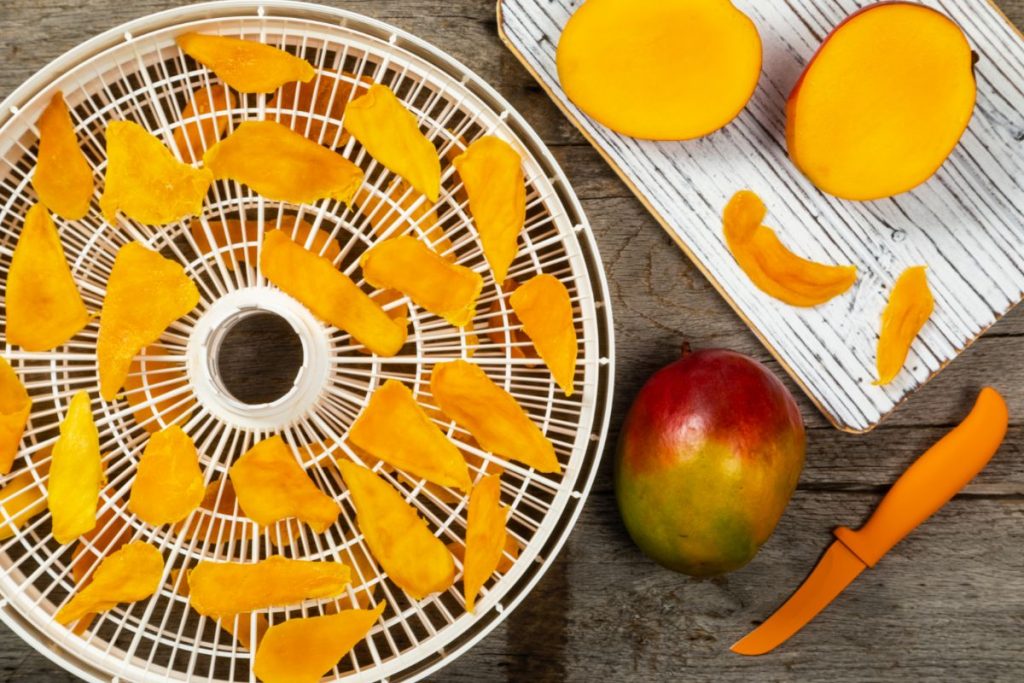From depression and weight loss management to fighting cancer and boosting energy levels, dried mango has many health benefits. It can be used to help manage digestive health and has been shown to improve blood glucose levels in those with Type 2 diabetes.
Table of Contents
Is Dried Mango Good for You?
Dried mango is good for your health, especially if it is homemade, unsweetened, and free of additives. Dried mango is full of nutrients that have been concentrated down from fresh mangos. Making dried mango at home is healthier because it avoids the preservatives and added sugars of store-bought dried fruit.
Unless you have asthma or diabetes, eating small amounts of unsulfured dried mango as a healthy snack is a good way of getting fiber and several key vitamins into your diet. Commercially dried mango should be avoided by those with asthma or diabetes as they can contain allergens and a high amount of added sugar.

What are the Benefits of Eating Dried Mango?
Here are the key health benefits of dried mango:
- Improved mood: The magnesium and folate (vitamin B9) in dried mango may alleviate symptoms of depression and anxiety.
- Reduced risk of inflammation: Dried mango contains carotenoids and polyphenols that reduce the risk of oxidation, diabetes, inflammation, and cancer.
- Cell preservation: Mangiferin, an antioxidant in mangoes, prevents and opposes cell damage in some body parts.
- Lower bad cholesterol: The fiber and pectin in dried mango help reduce bad cholesterol levels while promoting good cholesterol levels.
- Boosts energy levels naturally: The natural sugars in dried mango are better at sustainably boosting your energy levels than artificial sweeteners.
- Minerals for overall health: Dried mango contains selenium, copper, manganese, iron, potassium, and calcium. These minerals perform different functions, such as promoting heart health, regulating blood sugar, oxygen transportation, and nerve health.
- May help with weight loss: Dried mango makes an excellent replacement for sugary snacks. The fiber, concentrated carbs, and natural sugars in the fruit make you feel full.
- Improved eye health: Vitamin A, zeaxanthin, and lutein in dry mangos promote eye health and good vision. Vitamin A also supports reproduction, growth and development, organ functions, and a healthy immune system.
What is the Difference Between Dried Mango and Fresh?
The physical difference between dried and fresh mango is related to their water content. Dried mangos have a crispy or chewy texture, while fresh mangos are juicy and soft.
The drying process leads to the loss of water-soluble vitamins like vitamin C and concentrates both the sugar and fiber content of fresh mango. As a result, dried mango has twice the fiber and twice the sugar of fresh mango.

How Many Calories Are in a Serving of Dried Mango?
According to 2019 nutrition facts by the USDA, a 100-gram serving of ordinary sweetened dried mango has 350 calories, while organic dried mango has 333 calories.
Different mango varieties may have different nutrient levels, including the number of calories per serving. For this reason, it is important to always check the specific nutritional content of any packaged mango products.
How Many Carbs Does Dried Mango Have?
The USDA says 100g of organic dried mango has a carbohydrate content of 83.33g, while ordinary dried mangos have a carbohydrate concentration of 80g.
The high sugar and carbohydrate concentrations in dried mango necessitate limiting daily consumption in alignment with your nutritional needs and established daily values.
What is the Best Way to Eat Dried Mango?
Dried mango is best eaten as a healthy snack in the form of unsweetened chips. Besides eating the dried fruit as is, you can also add it to mango recipes such as:
- Baked goods
- Chutney
- Compotes
- Granola
- Green salads
- Homemade ice pops
- Smoothies
- Trail mixes with tree nuts
- Yogurt

How to Make Healthy Dried Mango at Home
Mango can be dehydrated in a food dehydrator, or it can be oven-dried. Making dried mango in a food dehydrator is the best way to produce a clean fruit snack without the risk of burning the fruits.
Follow these steps to dehydrate mango in a food dehydrator:
- Choose the best fresh mangos for dehydrating. Choose ripe, firm fruit with a slight give and a fragrant aroma.
- Wash the mangos in cold water and dry off the excess water with paper towels.
- Place the mangos on a cutting board and peel them with a vegetable peeler or sharp knife.
- Cut the mango cheeks close to the pit on either side. Slice the cheeks into 1/4-inch strips along the length.
- Arrange the mango slices on dehydrator trays in a single layer without overlapping them.
- Dry the mango slices for 8-12 hours until pliable and chewy or crispy. The degree of doneness will depend on your preference and how you want to use the dry mangos.
- After 8 hours, check the mangos for dryness. Take out a few slices and cool them to room temperature to test them. Fully dehydrated mangoes will produce no moisture when squeezed.
- Once the mango pieces are fully dry, remove them from the dehydrator and allow them to cool to room temperature.
- Put the dried mango slices in airtight containers and condition them for a week, shaking each container daily to ensure the pieces don’t stick together. Re-dehydrate mango pieces that cause condensation to form inside the container.
- Once conditioned, transfer the dried fruit into labeled, airtight containers for long-term storage. Keep them in a dry, dark place away from direct sunlight and humidity.

Is Dried Mango Good for Diabetics?
Contrary to popular belief, dried mango is good for people with diabetes when consumed in moderation. Research published in 2014 in the British Journal of Nutrition indicates that eating 10 grams of freeze-dried mango daily may help reduce blood sugar levels in obese people.
Dehydrated mango has a low glycemic index, but overeating it may significantly increase blood glucose levels. This increment may happen even if the fruit’s fiber helps reduce glucose absorption. Stick to smaller portions of dried mango or substitute with smaller servings of fresh mango if you have or are at risk of type 2 diabetes.
Does Dried Mango Help with Constipation?
The fiber in dried mango may help with constipation and digestion by stimulating bowel movements and peristaltic motions in constipated individuals. It also cleanses the gut and helps manage gut bacteria.
A 2018 study published in the Molecular Nutrition and Food Research Journal indicates that mango consumption helps improve the symptoms of constipation due to its fiber content. It has been shown to enhance stool shape, frequency, and consistency.
What is the Shelf Life of Dried Mangos?
Dried mango has a shelf life of 6-12 months when stored in airtight containers. You can use vacuum seal bags to improve the shelf life of dried mango and store the bags in a freezer to extend the shelf life by up to 12 months.

